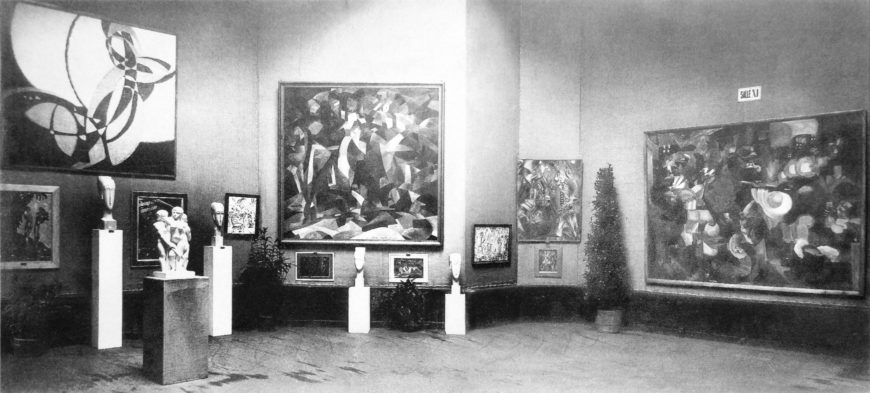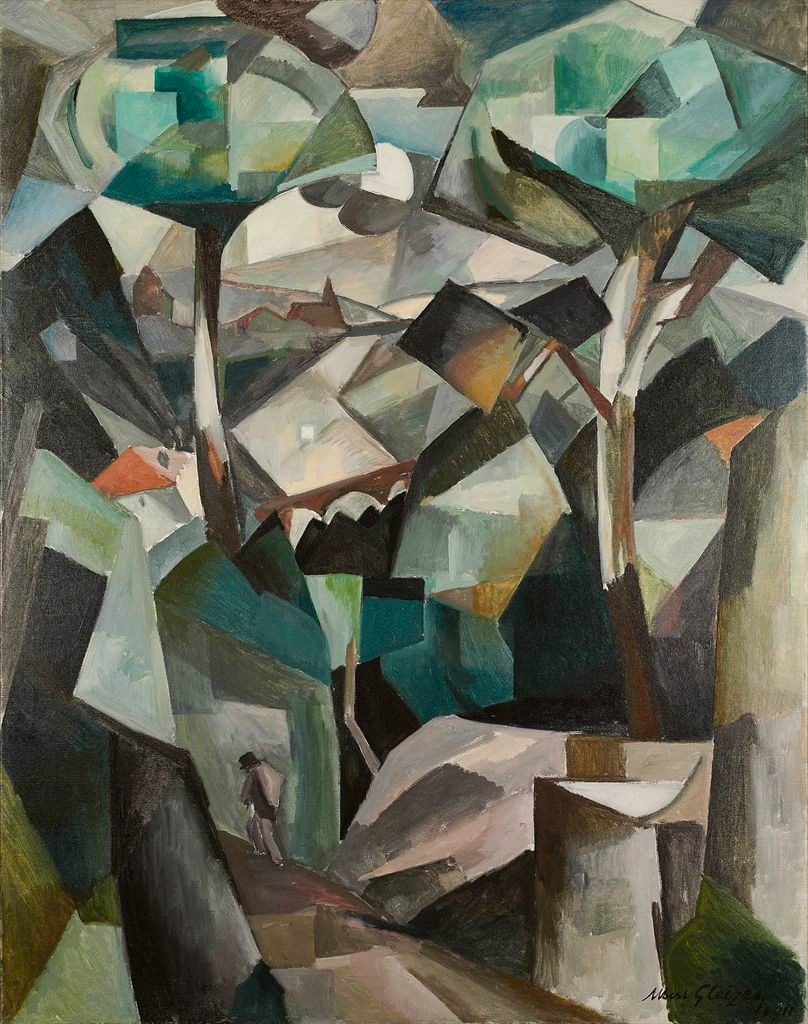The face of Cubism
Today, most people associate Cubism with Picasso and Braque, but in the early 1910s when the style was new, the works of many other Cubist artists, including Jean Metzinger, Albert Gleizes, Henri Le Fauconnier, and Fernand Léger, were better known. These artists are often called the Salon Cubists because they participated in the large annual public exhibitions in Paris known as Salons. Picasso and Braque, by contrast, had an exclusive contract with their dealer Daniel-Henry Kahnweiler and only showed their Cubist works in Paris at his private gallery.
The Salon Cubists lived and worked in Paris neighborhoods, mostly Montparnasse and suburban Puteaux, some distance from Picasso and Braque’s studios in Montmartre. They met frequently with writers and intellectuals to discuss a range of ideas including mathematics, physics, politics, and philosophy. The group was large; thirty artists exhibited over 200 works at their 1912 exhibition, La Section d’Or (The Golden Section). In the early 1910s their works appeared in modern art exhibitions throughout Europe.
A public profile
The Salon Cubists cultivated publicity; they showed their works as a group in order to attract attention in the overcrowded Salons. The Cubist Room at the 1911 Salon des Indépendants gained them public notice from purportedly scandalized viewers along with extensive critical recognition in newspapers and magazines.
By the time Cubism appeared, public outrage over modern art was a cliché. A long succession of modern art movements had led the public to expect incomprehensible new art works, and in the 1910s the number of “-isms” began to proliferate exponentially in both visual arts and literature. Cubism was one of the most prominent and successful movements claiming to represent the modern world in new, specifically modern ways. How it did so was, however, a matter of constant debate.
Big, ambitious paintings
Like Picasso and Braque, the Salon Cubists extended Cézanne’s exploration of the tensions and ambiguities of depicting three-dimensional objects in space on the flat surface of the picture plane. Salon Cubist paintings were, however, notably different from Picasso’s and Braque’s.
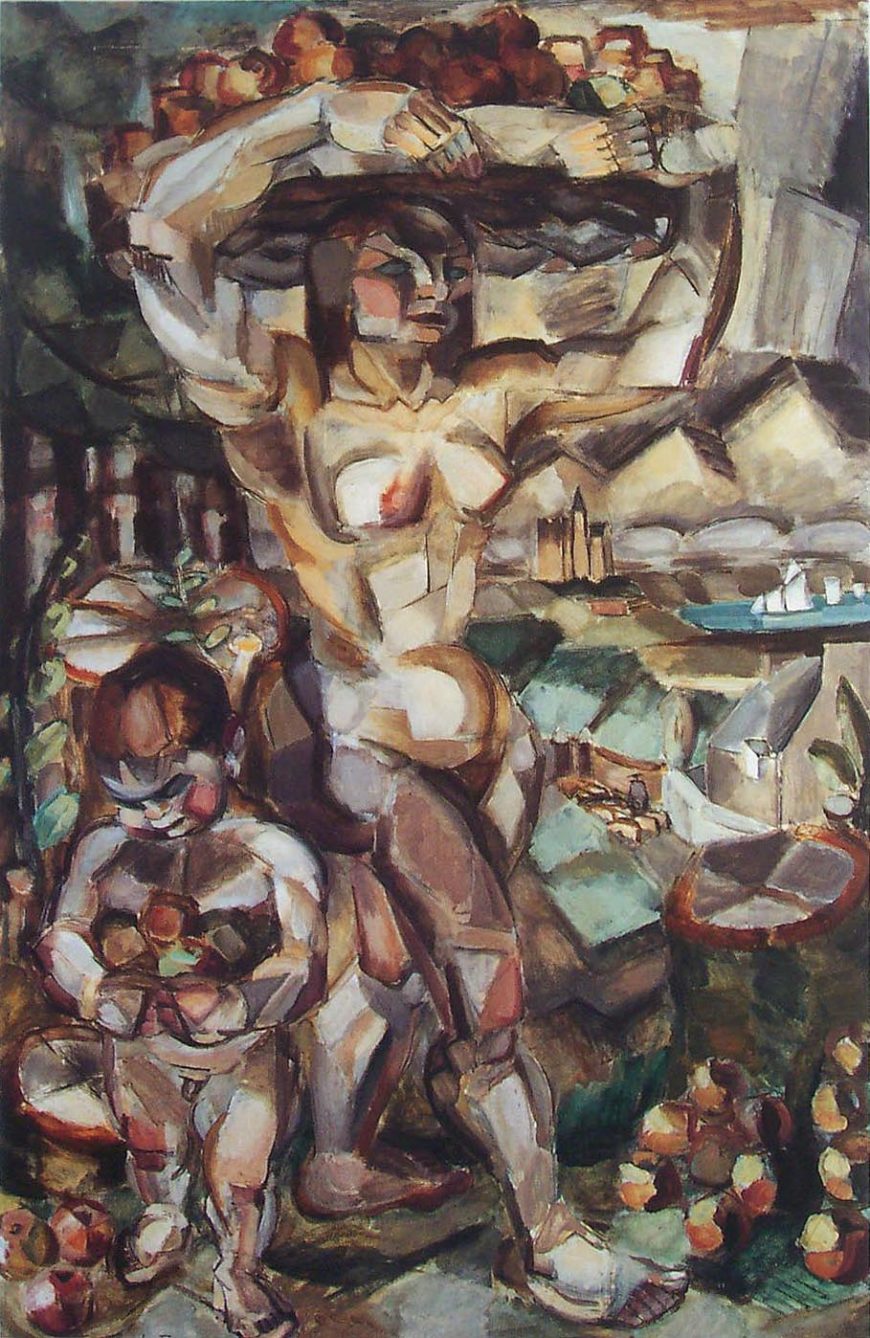
Henri Le Fauconnier, Abundance, 1910, oil on canvas, 191.5 x 123 cm (Kunstmuseum Den Haag)
The first difference is scale. Many Salon Cubist paintings were large. Henri Le Fauconnier’s Abundance, which was considered an important example of Cubist painting and exhibited widely throughout Europe in the 1910s, measures slightly over six by four feet. Picasso’s and Braque’s contemporary Cubist works were rarely more than a quarter that size, and often much smaller.
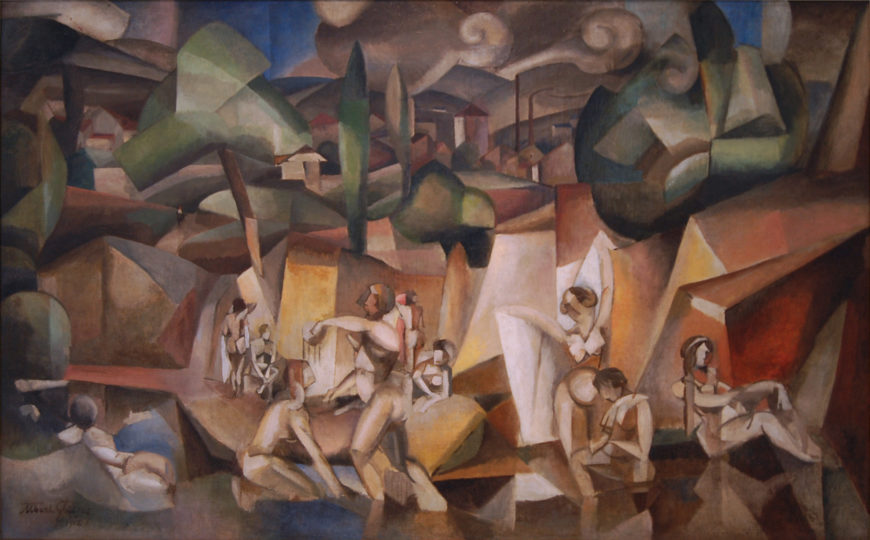
Albert Gleizes, The Bathers, 1912, oil on canvas, 105 x 171 cm (Musee d’art moderne de la Ville de Paris)
Another difference is subject matter. Picasso and Braque painted mostly still lifes and single figures in portrait format, while the Salon Cubists addressed grand themes and painted multi-figure compositions, landscapes, and cityscapes. Albert Gleizes’ The Bathers combines a pastoral scene of nude figures bathing in the foreground with the factory chimneys of a modern suburb smoking in the background. In Le Fauconnier’s Abundance an allegorical female nude and a child are surrounded by fruit symbolizing the fertility of the land, and by extension, nationalistic pride in France itself.
Conflicting interpretations
While Picasso and Braque never provided any explanation of their Cubist work, some Salon Cubists were more forthcoming. Albert Gleizes and Jean Metzinger published Du Cubisme (1912), which, despite its often vague and theoretically inconsistent text, was the most popular book on Cubist art for years. It was one of many texts on Cubism by critics, writers, and theorists eager to explain the new style.
Interpretations were often in conflict as critics attempted to explain how and why Cubist painters developed their non-naturalistic techniques of representation in relation to almost every scientific discovery and philosophical theory popular in the early 20th century. Some prominent critics and theorists analyzed Cubism as an art of conception (depicting what is known) rather than perception (depicting what is seen) in terms of the philosophy of Immanuel Kant. Cubist approaches to depicting figures and space were also frequently linked to non-Euclidean geometry and conceptions of space and time derived from both occultism and non-Newtonian physics. Another source for Cubist innovations was seen in the enormously popular anti-rationalist philosophy of Henri Bergson.

Jean Metzinger, Le Goûter, 1911, oil on cardboard, 29 7/8 x 27 5/8 inches (Philadelphia Museum of Art)
Bergsonian Cubism
Jean Metzinger’s Le Goûter can be used to illustrate a Bergsonian approach to interpreting Cubism. The painting, whose title translates both to “taste” and “tea-time,” shows a seated woman holding a spoon and touching a tea saucer. Bergson’s philosophy stressed the importance of the physical senses, particularly touch, taste, and smell, as sources of intuitive knowledge. Le Goûter is all about sensory experience. Its female subject is partially nude, traditionally intended to appeal to the (implied) heterosexual male viewer’s sense of touch as well as sight, and it depicts her using her own senses, touching the tea saucer while smelling and tasting her tea.
Typical Cubist techniques can also be interpreted in Bergsonian terms. In Le Goûter the woman’s head and the cup are depicted from different angles. We see the cup and saucer from the side on the left and from above on the right. The woman faces us directly on the right, and is in profile on the left. According to Bergson the world is not composed of static objects isolated in empty space. Instead everything exists in duration — a continuous flow of time and space. The Cubist technique of depicting things simultaneously from different vantage points can be understood as presenting a Bergsonian conception of reality by rejecting a static single view point and showing the object as constantly changing in the temporal and spatial flux. This is also indicated by the technique of passage, breaking the boundaries between solid objects and surrounding space, as Gleizes does on the woman’s left shoulder in Le Goûter.
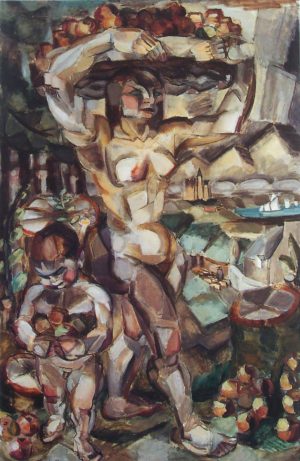
Henri Le Fauconnier, Abundance, 1910, oil on canvas, 191.5 x 123 cm (Kunstmuseum Den Haag)
Bergson’s concepts of intuition and élan vital can also be used to interpret Cubism. Élan vital is Bergson’s concept of a universal life force. In Le Fauconnier’s Abundance the vibrant and chaotic interlocking planes unify the figures, fruit, village and distant Alpine landscape into a visually active, faceted surface that suggests a vital force pulsating through everything. Élan vital cannot be directly perceived or even rationally understood, but it can be intuited. Bergson believed artists were particularly sensitive and intuitive beings in tune with the élan vital, and in their art they communicated their insights to the masses.
Products of the artist’s intuitive understanding, Cubist paintings with their non-rational spaces and ambiguous forms also prompted viewers to use their own intuition to complete the images in their minds. Gleizes’ The Path (Meudon) is a patchwork of geometric shapes that on examination reveals a scene of trees towering over a suburban village with a man walking in the foreground and a church on the horizon. The dynamic interlocking planes convey both a sense of movement and of unity, a world in which each part is connected to the whole in a vibrant, oscillating pattern suggestive of the vital force that animates the Bergsonian universe.
A kaleidoscope of modern experience
Some painters used Cubist forms to suggest a more abstract and extended interpenetration of space and time than Metzinger depicted in Le Goûter.
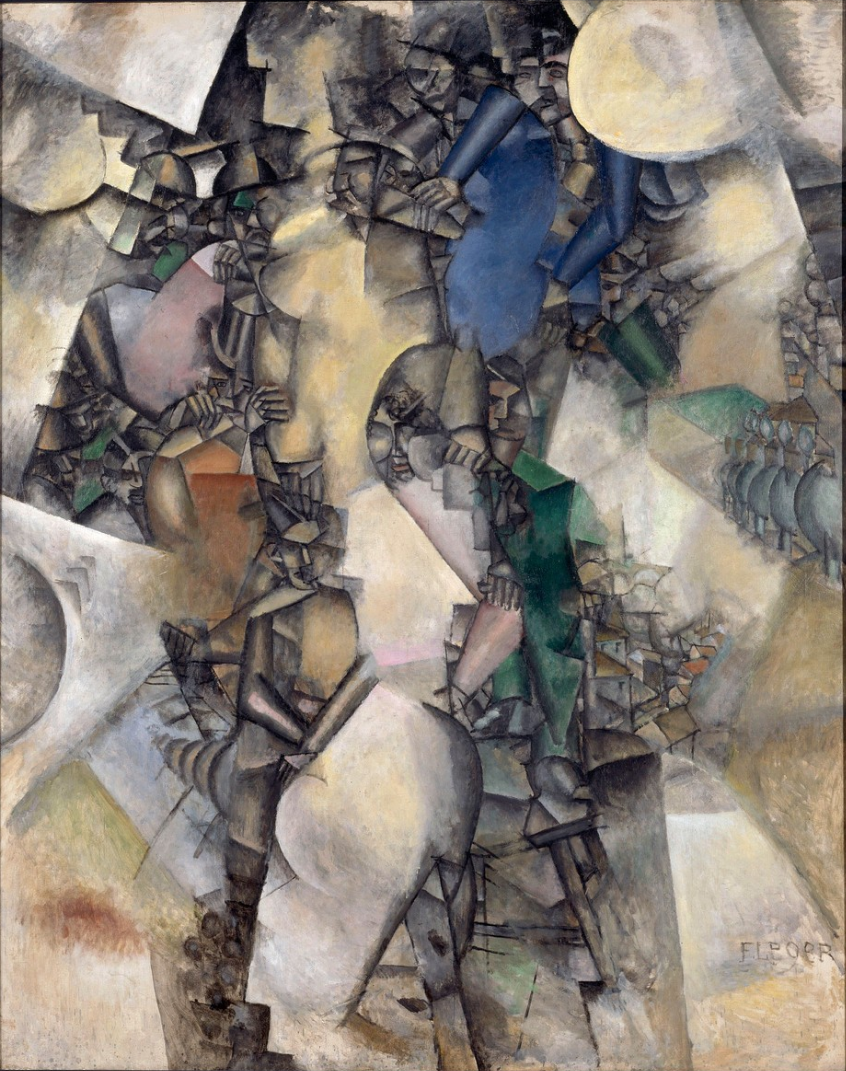
Fernand Léger, The Wedding, 1912, oil on canvas, 257 x 206 cm (MNAM Pompidou Center)
Fernand Léger’s The Wedding combines fragmented images of a crowded wedding celebration with aerial views of rooftops and a tree-lined street, interspersed with cloudy white abstract planes. His multiple views are more complex and disjointed than the comparatively legible scenes by Gleizes, Metzinger, and Le Fauconnier.
Léger’s painting suggests floating fragments of memory brought together in a kaleidoscope of shifting images. This conflation of different scenes in a single painting can be connected to Bergson’s notion of duration and to the related concept of simultaneity, which was understood by many artists of the time as a synthesis of memory and vision.
Ultimately, the work of the Cubist artists exhibiting in the Paris Salons was no more the product of a single unified theory than were the less public Cubist works of Picasso and Braque. The Salon Cubists used the new style to address a broad range of subjects and ideas, from traditional allegories and the celebration of nature to contemporary concepts of time and space.
Additional resources:

